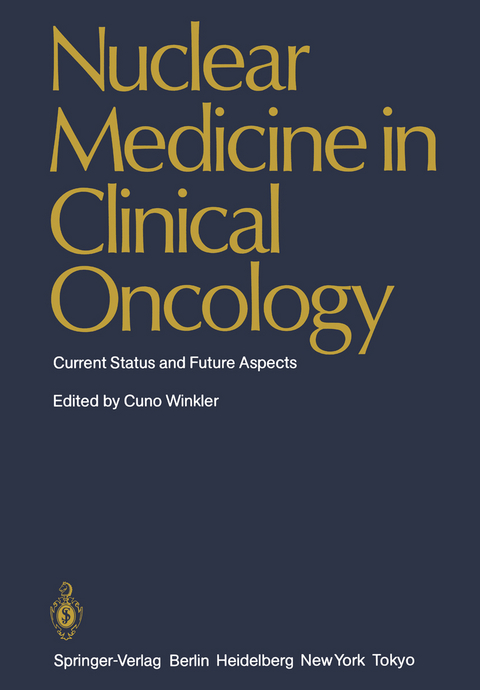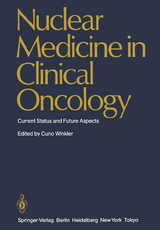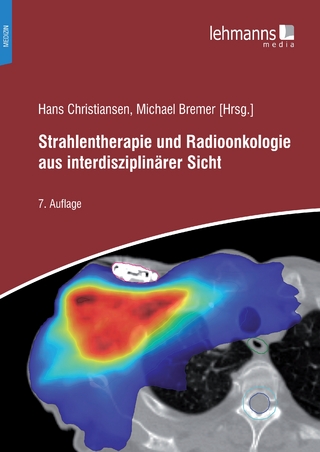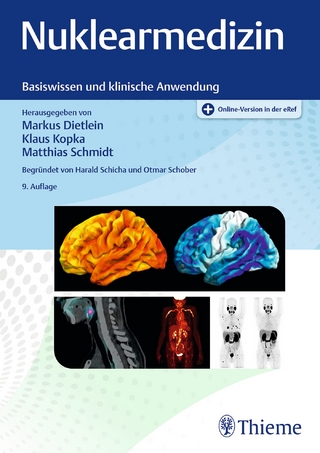Nuclear Medicine in Clinical Oncology
Springer Berlin (Verlag)
978-3-540-16164-6 (ISBN)
The introduction of nuclear medicine into oncology dates back to the early 1 940s, when Lawrence reported on the tumor retention of 32P-phosphate, von Hevesy and von Euler soon afterwards published their fundamental work on the metabolism of phosphorus in sarcoma cells, and when almost at the same time Keston and his coworkers de scribed their observation of the accumulation of radioactive iodine in metastases of a thyroid carcinoma. Since that time innumerable publi cations have appeared in oncologic literature which deal with the application of nuclear medical methods in experimental cancer re search and also in the diagnosis and treatment of malignant tumors. The significance of some originally very successfully applied clinical methods naturally has changed over the years. For instance, scin tigraphy became somewhat less important for the purely morpho logic assessment of certain tumors after the introduction of transmis sion computerized tomography and modem sonographic methods into clinical practice. On the other hand, however, it has also been possible to further develop scintigraphy to a decisive extent, both 'with refer ence to the test substances applied and in view of the instrumentation. As far as the scintigraphic equipment is concerned, the introduction of static and sequential digital imaging by means of scintillation camera computer systems in the mid-1960s represents important progress, as does the recent development of emission computerized tomography with single photon and positron emitters.
I. Introduction and Basic Considerations.- Nuclear Oncology: Current Role and Future Direction.- Nuclear Principles of Tumor Detection.- Mechanisms Responsible for Radioactive Tracer Uptake in Malignancies.- II. Technical Principles.- Gamma Camera Imaging and Single Probe Detection of Tumors.- Single Photon and Positron Emission Computerized Tomography in Tumor Diagnosis.- NMR Tomography of Cancer: Technical Considerations.- Parameter-Selective Proton NMR Imaging and Tissue Characterization In Vivo.- Development of Magnetic Resonance Contrast Media for Tumors.- Computer-Assisted Echographic Tissue Characterization in Tumor Diagnostics.- III. Diagnostic Use of Radiopharmaceuticals.- Clinical Aspects of Detection and Imaging of Brain Tumors.- Noncontact Eye Tumor Imaging with a Gamma Camera.- Clinical Aspects of Detection and Imaging of Differentiated Thyroid Tumors.- Clinical Aspects of Detection and Imaging of Lung Tumors.- Clinical Aspects of Detection and Imaging of Tumors of Liver and Spleen.- Use of Scintigraphy for Evaluation of Patients with Renal Malignancies.- Scintigraphy of Lymphokinetics and Lymphatic Neoplasia.- Bone Scintigraphy in Primary Malignant Bone Tumor.- Scintigraphic Detection of Bone Metastases.- Metaiodobenzylguanidine in the Diagnosis of Neuroblastomas.- Scintigraphic Imaging of Pheochromocytomas by Means of Metaiodobenzylguanidine (MIBG).- Nuclear Medicine in the Diagnosis of Skin Tumors.- IV. Radioimmunodetection.- Principles of Radioimmunodetection of Tumors.- Immunoscintigraphy of CEA-Producing Tumors with Special Emphasis on the Use of Mab Fragments and ECT.- Beta-hCG and Related Germ Cell Tumor Antigens in Radioimmunodetection.- Radioimmunodetection with Monoclonal Antibodies Against Prostatic Acid Phosphatase.- Immunoscintigraphy of Ovarian Cancer by Means of HMFG2 Monoclonal Antibody.- Immunoscintigraphy of Gynaecological Tumors.- Radioimmunoscintigraphy by Means of Melanoma Antibody.- Radioimmunoscintigraphy of CA 19-9/CEA Producing Tumors Using I-131 Labeled F (ab?)2 Fragments of Monoclonal Antibodies (19-9/Anti-CEA Radioimmunococktail).- Radioimmunodetection of Malignant Melanoma with Radiolabelled (131I, 123I, 111In, 99mTc) Monoclonal Antibodies and F (ab?)2 Fragments.- Imaging of Bone and Soft Tissue Tumors Using an Antitumor Monoclonal Antibody.- V. Nuclear Magnetic Resonance Imaging and In Vivo Spectroscopy.- Current Status of Magnetic Resonance Imaging of the Central Nervous System.- NMR Imaging of Tumors in the Body Stem.- NMR In Vivo Spectroscopy in Tumor Diagnosis.- VI. Positron Emission Tomography.- Production and Use of Positron-Emitting Test Substances for Tumor Diagnosis.- Uptake of 11C-Aminocyclopentane Carboxylic Acid (ACPC) and 13N-Ammonia in Malignant Tumors. A Comparative Clinical Study.- Analysis of Brain Tumor Physiology by Positron Emission Tomography.- VII. Use of Tumor Markers In Vitro.- Overview of the Development of Tumor Markers.- The Clinical Value of Tumor-Associated Proteins in Gastrointestinal Cancer.- The Value of Tumor Markers in the Diagnosis of Urogenital Carcinoma.- Tumor Markers for Monitoring Therapy in Lung Cancer.- Tumor Markers for Follow-Up of Thyroid Carcinoma.- Use of Tumor Markers for Patient Monitoring in Breast Cancer.- Tumor Markers for Monitoring Breast Cancer Patients.- VIII. Therapeutic Use of Radiopharmaceuticals Including Labelled Antibodies.- Radioiodine Treatment of Thyroid Carcinomas.- Therapy of the Neuroblastoma with 131I-MIBG.- Treatment of Pheochromocytomas with 131I-Metaiodobenzylguanidine.- Treatment of Neuroblastoma by131I-Metaiodobenzylguanidine (131I-MIBG): Qualitative and Quantitative Scintigraphic Evaluation of the Treatment Effect.- Endolymphatic Radionuclide Therapy (ELRT) in Malignant Melanoma of the Lower Extremities.- On the Efficacy of Strontium-89 Therapy. Preliminary Evaluation of a Double-blind Study.- Cancer Treatment with Radioactive Labeled Antibodies.- Treatment of Pleural and Peritoneal Carcinosis with Radioactive Colloids.- Treatment of Hepatic Malignancies by Intravascular Administration of Radioisotopes.- Treatment of Local Prostatic Cancer by 125Iodine Seeds.- CT-Guided Stereotactic Implantation with Iridium-192 and Iodine-125 of Non-Resectable Intracranial Tumors.- IX. Experimental Approaches and Future Aspects.- Radioimmunodetection of Hodgkin Tumors in Nude Mice.- Immunoscintigraphy of Human Pancreatic Carcinoma in Nude Mice with F(ab?)2 Fragments of Monoclonal Antibodies to CA 19-9 and CEA.- Physico-chemical Properties and Biokinetics of Tumor-Affine Metal (M)-Ligand-Complexes.- Iodoazomycin Riboside [1-(5?-iodo-5?-deoxyribofuranosyl)-2-nitroimidazole],a Hypoxic Cell Marker. In Vivo Evaluation in Experimental Tumors].- The Potential Use of Alpha and Auger-Electron Emitting Radionuclides for Therapy.- Studies on the In Vivo Stability of 211At Labelled Albumin Particles in Mice.
| Erscheint lt. Verlag | 1.4.1986 |
|---|---|
| Co-Autor | J. Adelstein |
| Zusatzinfo | XVIII, 420 p. 57 illus. |
| Verlagsort | Berlin |
| Sprache | englisch |
| Maße | 170 x 244 mm |
| Gewicht | 1040 g |
| Themenwelt | Medizin / Pharmazie ► Medizinische Fachgebiete ► Onkologie |
| Medizinische Fachgebiete ► Radiologie / Bildgebende Verfahren ► Nuklearmedizin | |
| Schlagworte | carcinoma • Diagnosis • Diagnostics • Imaging • Positron Emission Tomography • Tumor |
| ISBN-10 | 3-540-16164-3 / 3540161643 |
| ISBN-13 | 978-3-540-16164-6 / 9783540161646 |
| Zustand | Neuware |
| Haben Sie eine Frage zum Produkt? |
aus dem Bereich




